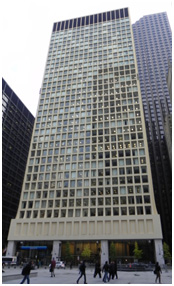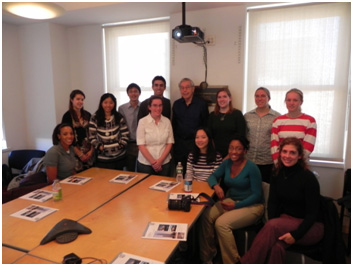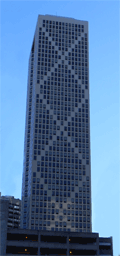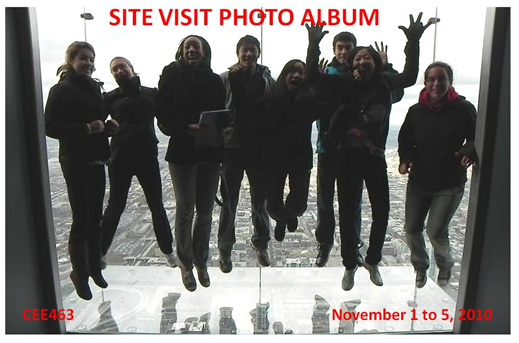Site Visit of CEE463 Class
It is rare for a student in civil engineering to visit exemplary works of structural engineering; yet it is expected for a student in architecture or art history to visit the prototypical projects or artifacts that they are studying. Part of the reason that engineers are not making such visits is that they are incorrectly seen by our culture, and even by many in their own profession, as ‘technicians’ that have no need to experience structures in multi-dimensions. However, these visits are inspiring and instructive beyond anything that is possible in the classroom.
Site visits give one a sense of scale that is not possible to fully experience through photographs. One also becomes intimately connected and fully curious about the construction process. The connections are observed up close and the details of bolts and welds that comprise the simple or sometimes complex part of the steel design is seen. For a concrete structure the imprint of the form boards that reminds one that formwork (what molds the concrete) needs to be built before the concrete can be poured. During a site visit one can also observe the durability of the structure over time, which is a measure of sustainability. By observing these structures ‘in action’, one can measure the success or failure to meet the structure’s functionality and one understands the structure’s relationship to the community.
| Cover of the travel booklet produced by the students |
Before making the visit, the students in CEE463 had begun their study of one of Khan’s buildings through a structural analysis and a study of the social context. They summarized their findings in a little pocket size travel booklet that was printed and taken on site visits to New York, Chicago and Houston. Before visiting each tall building, the students read the information in the travel booklet. On site, each student team explained “their” tall building: the way the structural system works, how it was built, and the social context of it to the rest of the group. During these visits, all students studied carefully the structure, its details, its surroundings, and got a sense for the relationship to the community.
 |
 |
| The two students on the left studied Fazlur Khan’s Brunswick Building (which has a significant meaning for the engineering of tall buildings). They are teaching the rest of the class about this building. |
We were given private tours of Bank of America Tower, New York Times Building, 780 Third Avenue, Times Square Tower, Chestnut DeWitt Apartments, John Hancock Center, One Shell Plaza and Two Shell Plaza. In these tours, we were given access to restricted areas and our gracious hosts also provided valuable information about the building from an engineering and management point of view. Our students also visited consulting structural engineering firms. In New York City we went to the offices of Severud Associates, Thornton Tomasetti, and Leslie E. Robertson Associates, In Chicago we visited SOM. At all of these firms, practicing engineers gave us a tour of their office, presentations of important projects that they have worked on, and also advise to our students about their education and career. The photo album on this website gives some images and impressions of the site trip, which based on the student feedback was a very valuable experience in many personal and professional ways.
 |
 |
| Visiting with Dan Jadeja from Rosenwasser/Grossman Consulting Engineers in NYC, who worked with Khan on the building in the photo (780 3rd Ave.). | Visiting the office of Leslie E. Robertson Associates (Mr. Robertson is in the back center). |



